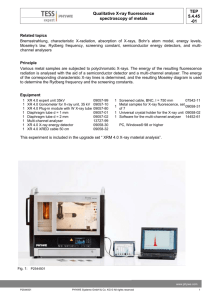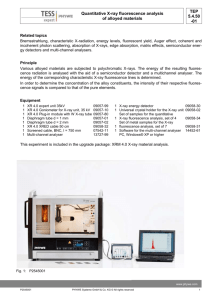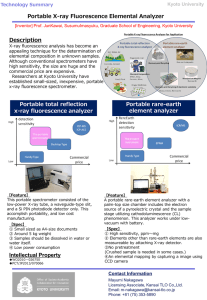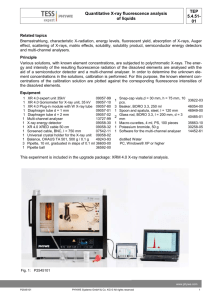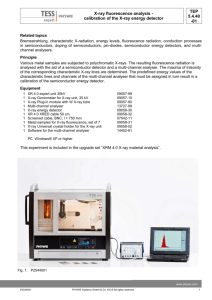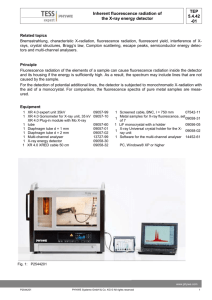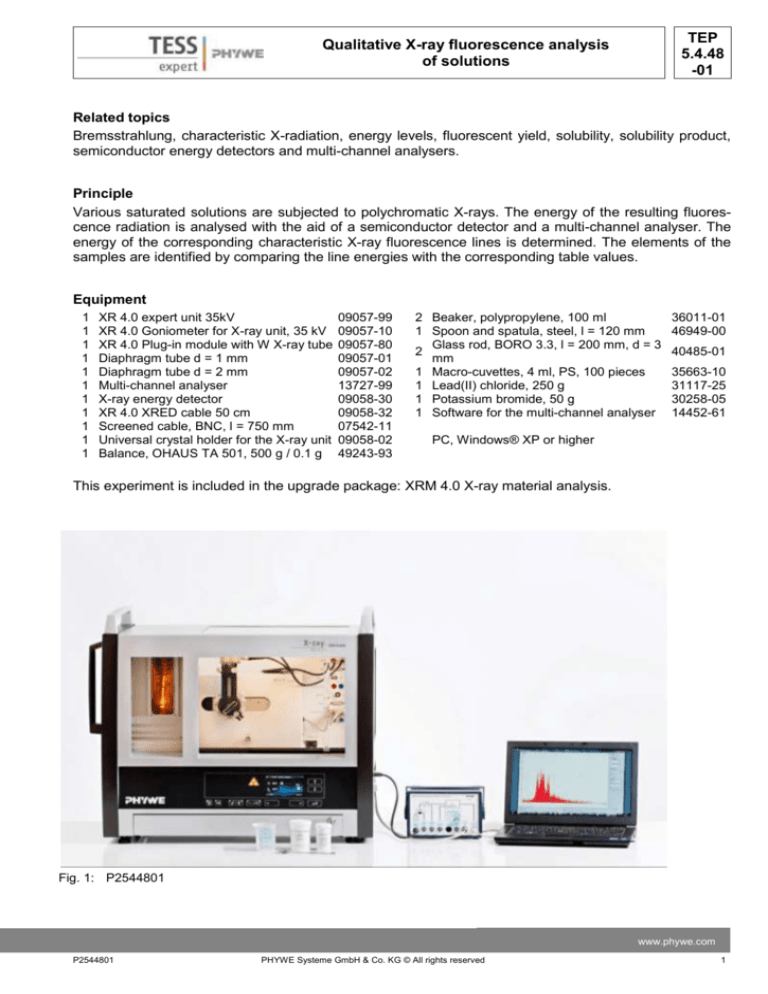
TEP
5.4.48
-01
Qualitative X-ray fluorescence analysis
of solutions
Related topics
Bremsstrahlung, characteristic X-radiation, energy levels, fluorescent yield, solubility, solubility product,
semiconductor energy detectors and multi-channel analysers.
Principle
Various saturated solutions are subjected to polychromatic X-rays. The energy of the resulting fluorescence radiation is analysed with the aid of a semiconductor detector and a multi-channel analyser. The
energy of the corresponding characteristic X-ray fluorescence lines is determined. The elements of the
samples are identified by comparing the line energies with the corresponding table values.
Equipment
1
1
1
1
1
1
1
1
1
1
1
XR 4.0 expert unit 35kV
XR 4.0 Goniometer for X-ray unit, 35 kV
XR 4.0 Plug-in module with W X-ray tube
Diaphragm tube d = 1 mm
Diaphragm tube d = 2 mm
Multi-channel analyser
X-ray energy detector
XR 4.0 XRED cable 50 cm
Screened cable, BNC, l = 750 mm
Universal crystal holder for the X-ray unit
Balance, OHAUS TA 501, 500 g / 0.1 g
09057-99
09057-10
09057-80
09057-01
09057-02
13727-99
09058-30
09058-32
07542-11
09058-02
49243-93
2 Beaker, polypropylene, 100 ml
1 Spoon and spatula, steel, l = 120 mm
Glass rod, BORO 3.3, l = 200 mm, d = 3
2
mm
1 Macro-cuvettes, 4 ml, PS, 100 pieces
1 Lead(II) chloride, 250 g
1 Potassium bromide, 50 g
1 Software for the multi-channel analyser
36011-01
46949-00
40485-01
35663-10
31117-25
30258-05
14452-61
PC, Windows® XP or higher
This experiment is included in the upgrade package: XRM 4.0 X-ray material analysis.
Fig. 1: P2544801
www.phywe.com
P2544801
PHYWE Systeme GmbH & Co. KG © All rights reserved
1
TEP
5.4.48
-01
Qualitative X-ray fluorescence analysis
of solutions
Safety instructions
When handling chemicals, you should wear suitable
protective gloves, safety goggles, and suitable clothing. Please refer to the appendix for detailed safety
instructions.
Tasks
1. Calibrate the semiconductor energy detector
with the aid of the characteristic radiation of the
tungsten X-ray tube.
2. Record the fluorescence spectra of saturated potassium bromide and lead chloride solutions.
3. Determine the energy values of the correspond- Fig. 2: Connections in the experimentation area
ing fluorescence lines and comparison with the
corresponding table values.
Note
Please comply with the relevant safety instructions
when handling and disposing of chemicals.
Fig. 3: Connection at the external panel of the XR 4.0 XSet-up
ray expert unit to the MCA
- Screw the adapter ring onto the inlet tube of the
energy detector.
X-ray energy
- Connect the signal and supply cables to the cordetector
responding ports of the detector with the aid of
the right-angle plugs.
- Connect the signal and supply cables from the
MCA to the appropriate connections in the experiment chamber of the X-ray unit (signal cable: red, supply cable: green (see Fig. 2)).
Left position of the
- Connect the external ports for the X RED of the
goniometer
x-ray unit (signal cable red, supply cable green,
see Fig. 3) to the multi-channel analyse (MCA).
Universal crystal
Connect the signal cable via a screened BNCholder with filled cucable to the “Input” port of the MCA and the
vette
supply cable to the “X-Ray Energy Det.” port of
the MCA.
- Secure the energy detector in the holder of the
swivel arm of the goniometer. Lay the two cables with sufficient length so that the goniometer
can be swivelled freely over the entire swivelling
range.
- Connect the multi-channel analyser and computer with the aid of the USB cable.
Fig. 4: Set-up at the goniometer
2
PHYWE Systeme GmbH & Co. KG © All rights reserved
P2544801
Qualitative X-ray fluorescence analysis
of solutions
-
TEP
5.4.48
-01
Insert the tube with the 2-mm-aperture.
Bring the goniometer block and the detector to
their respective end positions on the left. Bring
the detector to the 90° position in the 2:1 coupling mode (Fig. 4).
Calibration of the multi-channel analyser
(if there is no other already existing calibration that
can be used)
- Bring the goniometer block and the detector
to their respective end positions on the
right.
Fig. 5: calibration of the multi-channel analyser
- Insert the tube with the 1 mm-aperture into
the exit tube of the X-ray tube.
- With the X-ray unit switched on and the door locked, bring the detector to the 0° position. Then,
shift the detector by some tenths degree out of the zero position in order to reduce the total rate.
- Operating data of the tungsten X-ray tube: Select an anode voltage UA = 25 kV and an anode
current IA = 0.02 mA and confirm these values by pressing the “Enter” button.
- Switch on the X-radiation
- In the MEASURE program, select “Multi channel analyser” under “Gauge”. Then, select “Settings
and calibration”. After the “Calibrate” button has been clicked, a spectrum can be measured. The
counting rate should be < 300 c/s. Energy calibration settings: - 2-point calibration, - Unit = keV,
Gain = 2 – Set the offset so that low-energy noise signals will be suppressed (usually a few per
cent are sufficient), See Fig 5.
- Measuring time: 5 minutes. Use the timer of the X-ray unit.
- Make the two coloured calibration lines congruent with the line centres of the two characteristic
X-ray lines. The corresponding energy values (see e.g. P2544701) E(L3M5/L3M4) = 8,41keV and
E(L2N4) = 9,69 keV are entered into the corresponding fields, depending on the colour. (Note:
Since a separation of the lines L3M5 and L3M4 Lines is not possible, the mean value of both lines
is entered as the energy of the line).
- Name and save the calibration.
Procedure
Sample preparation
In order to produce high-intensity fluorescence lines, saturated solutions must be prepared. To do so,
add approximately 0.5 g of PbCl2 into 50 ml of water, and approximately 32 g of KBr into another 50 ml
of water. Then, fill the plastic cuvettes to ¾ with the saturated solutions.
Spectrum recording
- Insert the tube with the 2-mm-aperture.
- Bring the goniometer block and the detector to their respective end positions on the left.
- Bring the detector to the 90° position in the 2:1 coupling mode (the sample holder must then be
aligned to 45°)
- Fasten a filled plastic cuvette to the universal holder with some double-sided adhesive tape so that a
flat side of the cuvette is hit by the primary x-ray beam (see Fig 4).
- Operating data of the tungsten X-ray tube: Adjust an anode voltage Ua = 35 kV and an anode current
so that the counting rate is ≤ 200 c/s.
- Measuring time: 10 minutes (use the timer of the X-ray unit).
www.phywe.com
P2544801
PHYWE Systeme GmbH & Co. KG © All rights reserved
3
TEP
5.4.48
-01
Qualitative X-ray fluorescence analysis
of solutions
Evaluation of the measurement curves
- In order to determine the line energy, switch from the bar display to the curve display. To do so, click
“Display options” and then “Interpolation and straight lines”.
- Extend the relevant line section with the zoom function
. Open the window “Function fitting
-
Then, select the curve section with
normal distribution”.
-
Find the line centroid with the function “Survey”
”. Then, select “Scaled
.
Theory and Evaluation
When X-rays interact with matter, they lose energy. In the range of energy that is available during this
experiment, the photoelectric effect plays the most important role. This means that in the atom on one of
the lower shells an electron is ejected due to the absorbed photon energy. The now free space is taken
by an electron from one of the higher shells. The energy that is produced during this process can be
used for the ejection of another electron from one of the higher shells (Auger effect) or for the generation
of a photon (fluorescence radiation). Since the energy of the energy levels that are involved in this process is atom-specific, the type of the emitting atom can be determined based on the energy of the fluorescence radiation. In order to determine the type of atom, the experimental energy values are then
compared to the corresponding table values (e.g. “Handbook of Chemistry and Physics”-CRC-Press, Inc.
USA). During the assignment of the fluorescence lines, it must be taken into consideration that the relaxations that follow the primary ionisation process can only take place if they fulfil the quantum-mechanical
selection rules Δj = 0, ± 1 and Δl = ± 1 (j = total angular momentum, l = orbital angular momentum).
Task 2 and 3: Record the fluorescence spectra of
saturated potassium bromide and lead chloride solutions and determine the energy values of the corresponding fluorescence lines and comparison with
the corresponding table values.
Figure 6 shows the fluorescence spectrum of potas1 2
3 4
5
sium bromide. Only the high-intensity characteristic
↓↓
↓ ↓
↓
Kα- and Kβ-radiation of bromide (line 3 and 4) can
be clearly identified. The energy of the characteristic
fluorescence radiation of potassium is close to the
sensitivity limit of the energy detectors, which is why
it cannot be identified in this experiment. The lines 1
(E = 7.41 keV), 2 (E = 8.04 keV) and 5 (E = 16.35 Fig. 6: Kα- und Kβ-fluorescence lines of bromine
keV), which are just visible, are caused by nickel
and copper. The scattered primary radiation generates fluorescence radiation on the material components nickel and copper of the detector housing. This
fluorescence radiation is also detected by the detector.
Figure 7 shows the fluorescence spectrum of the lead chloride solution. The lines 1, 3, and 7 can be reassigned to the elements nickel, copper, and molybdenum. The other lines are part of the characteristic
L-radiation of lead. The energy of the fluorescence radiation of chlorine is below the detection sensitivity
of the detector.
Table 1 shows the evaluation of the spectra of Figure 2 and Figure 7.
The Lγ1-line (line 6) clearly becomes asymmetric towards the high-energy side. This is due to the lowintensity Lγ2,3-lines of lead with a slightly higher energy, which cannot be separated clearly in this experiment.
4
PHYWE Systeme GmbH & Co. KG © All rights reserved
P2544801
TEP
5.4.48
-01
Qualitative X-ray fluorescence analysis
of solutions
Table 1: Assignment of the characteristic fluorescence lines of potassium bromide and lead chloride
Atomic number
Z
35
Element
Line
Eexp./ keV
Elit. / keV
Transition
Br
82
Pb
3
4
3
4
5
6
11,83
13,20
9,18
10,52
12,58
14,84
11,92
13,29
9,18
10,45 / 10,55
12,61
14,76
KL2,3 - Kα
KM3 - Kβ
L3M1 - Ll
L3M4,5 - Lα1,2
L2M4 - Lβ1
L2N4 - Lγ1
Fig. 7: Zoomed representation with a fitted normal distribution of the Kα- and Kβ-line of bromide.
1
2
3
4
5
6
7
↓
↓
↓
↓
↓
↓
↓
Fig. 8: L-fluorescence lines of lead
www.phywe.com
P2544801
PHYWE Systeme GmbH & Co. KG © All rights reserved
5
TEP
5.4.48
-01
Qualitative X-ray fluorescence analysis
of solutions
Disposal
Do not dispose of heavy-metal-containing waste via household waste.
Appendix
Hazard symbol, signal word
Hazard statements
Precautionary statements
H315: Causes skin irritation
H319: Causes serious eye
irritation
H335: May cause respiratory irritation
P261: Avoid breathing
dust/fume/gas/mist/vapo
urs/spray.
P305 + P351 + P338: IF
IN EYES: Rinse cautiously with water for
several minutes. Remove contact lenses, if
present and easy to do.
Continue rinsing.
Potassium bromide (KBr)
Lead(IV) oxide (PbO2)
Danger
6
H302: Harmful if swallowed
H332: Harmful if inhaled
H360: May damage fertility or the unborn child
H373: Causes damage to
organs through prolonged
or repeated exposure
H410: Very toxic to aquatic life with long lasting effects
PHYWE Systeme GmbH & Co. KG © All rights reserved
P201: Obtain special instructions before use.
P273: Avoid release to
the environment.
P308 + P313: IF exposed or concerned: Get
medical advice/attention.
P2544801

